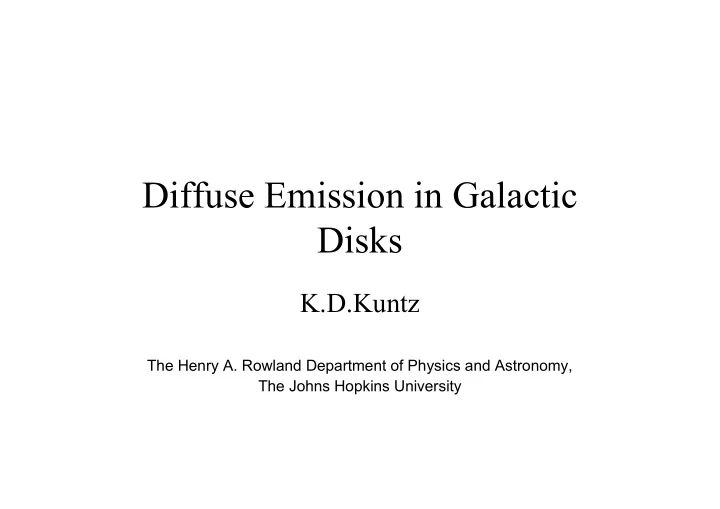

Diffuse Emission in Galactic Disks K.D.Kuntz The Henry A. Rowland Department of Physics and Astronomy, The Johns Hopkins University
Motivation I • Diffuse and Pseudo-diffuse emission in the Milky Way has multiple sources • Most of the emission is soft • Due to absorption, our knowledge is limited to R<1kpc • Our view of the X-ray galaxy may be biased Urbino 2008
Milky Way Summary Soft Halo kT~0.09 keV SuperBubble kT~0.25 keV Gal. Ridge Disk kT~7.0 keV kT~0.6 keV SNR LHB Gal. Bulge kT~0.35 keV kT~0.09 Hard Halo kT~0.2 keV SFR kT~0.2,0.6 XAS-7/2007 Summary
Motivation I • Diffuse and Pseudo-diffuse emission in the Milky Way has multiple sources • Most of the emission is soft • Due to absorption, our knowledge is limited to R<1kpc • Our view of the X-ray galaxy may be biased Urbino 2008
Motivation II • Study of the disks in other galaxies – Allows study of overall structure (morphology) and luminosity – Allows study of properties averaged over large areas – Does not allow detailed study of individual sources • Statistical study of galaxies reveal (Shapley&Fabbiano) – X-ray emission from early type spiral correlated with B&H (thus old stellar populations) – X-ray emission from late type spirals correlated with FIR (thus with star-formation and young stellar populations) – Correlations determined from total X-ray luminosity (thus point-source & diffuse emission together, bulge & disk together) Urbino 2008
Motivation III New instruments allow finer analysis: How does X-ray luminosity vary with Hubble type? How does the X-ray spectrum vary with Hubble type? A quick survey of the Chandra archive reveals: • Most galactic disks can be fit with 2 thermal components • The temperature of those components ~ constant • The ratio of hotter comp:cooler comp is a f(Hubble T) – Later type disks are more dominated by cooler (kT=0.25) gas • However, sample misses earlier type disks (Sab) – Typically because they are not X-ray bright Urbino 2008
Opportunity • The nearest galaxy with the largest amount of data M31, Sab Urbino 2008
Opportunity • Although there is a large amount of Chandra data – Misses the star-formation ring – Mostly with the FI chips – Study concentrates on the bulge Urbino 2008
Opportunity • Although there is a large amount of Chandra data – Misses the star-formation ring – Mostly with the FI chips – Study concentrates on the bulge Urbino 2008
Opportunity • XMM-Newton has a large amount of data – Instrument more optimized for soft diffuse emission – Covering star-forming ring Urbino 2008
Opportunity • XMM-Newton has a large amount of data – Instrument more optimized for soft diffuse emission – Covering star-forming ring Urbino 2008
Opportunity • M31 diffuse emission studied once (Trudolyubov et al) – Used only three fields – Before XMM background was understood Urbino 2008
Project • Use the five exposures with the strongest star formation • Use four exposures near M31 by not on the disk as “blank sky fields” to determine the fore/background spectrum • Use the newest, most sophisticated background techniques • To isolate the emission due to the M31 disk • To measure the spectrum for comparison to other galaxies Urbino 2008
Project First cut analysis • Some fraction of emission is unresolved point sources (spectrum not well characterized) (more can be done to characterize it) • Will assume no internal absorption (but not a significant impact on the analysis) • Will assume solar abundances (gas phase abundances probably not available) • Newer data has curious background properties (under investigation) • More data of potential interest exists Urbino 2008
Project Nuts&Bolts 1. Retrieve some of the auxiliary data from archive 2. Use XSPEC to fit the spectra 1. of the background fields (joint with ROSAT) 2. Of the M31 data 3. If time allows, 1. extract more XMM data from archive 2. Use SAS and XMM-ESAS to reduce to spectra Urbino 2008
Recommend
More recommend